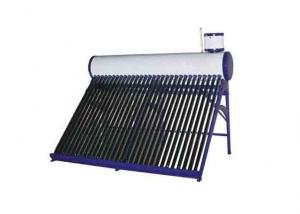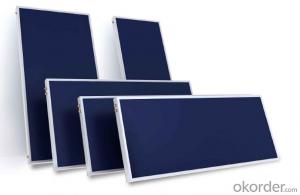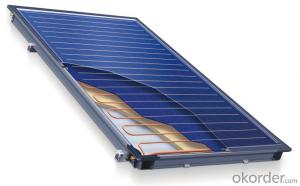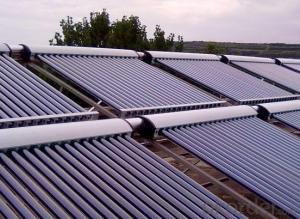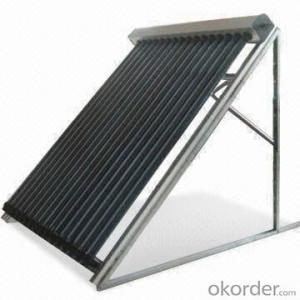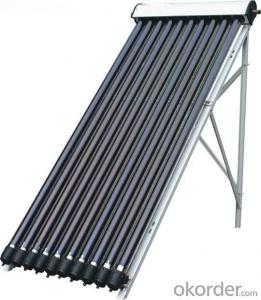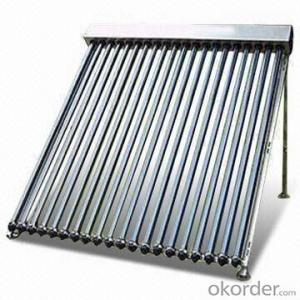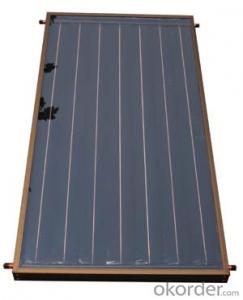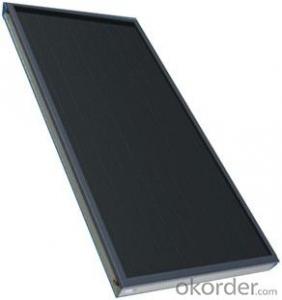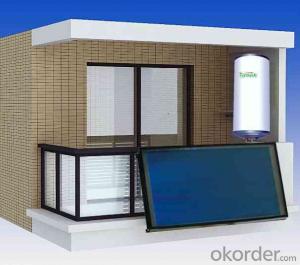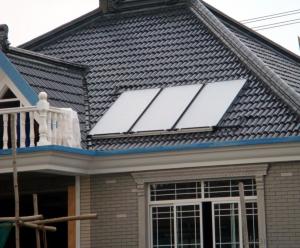Thermomax Evacuated Tube Solar Collectors Integrated with Solar Photovoltaic Polycrystalline Modules
- Loading Port:
- Tianjin
- Payment Terms:
- TT OR LC
- Min Order Qty:
- 1 pallet
- Supply Capability:
- 100000000 pallet/month
OKorder Service Pledge
OKorder Financial Service
You Might Also Like
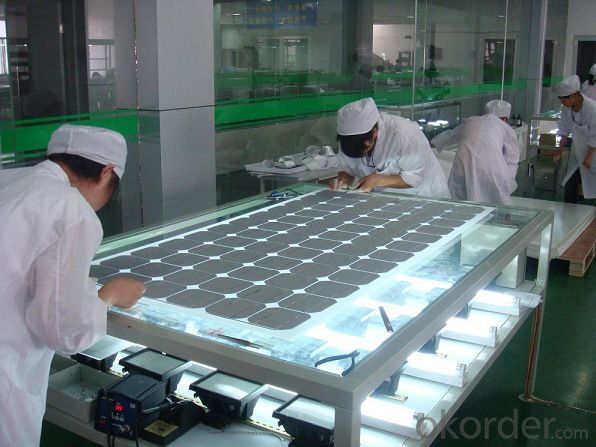
Solar panel refers either to a photovoltaic (PV) module, a solar hot water panel, or to a set of solar photovoltaic modules electrically connected and mounted on a supporting structure. A PV module is a packaged, connected assembly of solar cells. Solar panels can be used as a component of a larger photovoltaic system to generate and supply electricity in commercial and residential applications. Each module is rated by its DC output power under standard test conditions, and typically ranges from 100 to 320 watts. The efficiency of a module determines the area of a module given the same rated output – an 8% efficient 230 watt module will have twice the area of a 16% efficient 230 watt module. There are a few solar panels available that are exceeding 19% efficiency. A single solar module can produce only a limited amount of power; most installations contain multiple modules. A photovoltaic system typically includes a panel or an array of solar modules, an inverter, and sometimes a battery and/or solar tracker and interconnection wiring.
Specifications:
solar panels from 5W--300W, made of TAIWAN MOTECH brand cells,with CO in TAIWAN,Mono and Poly with VDE,IEC,CSA,UL,CE,ISO.
We import solar cells from Taiwan Motech brand, with this CO in taiwan and our CSA certification,we can still sell goods to Anti-dumping areas like USA. Our main products are solar panels, off grid and on grid solar home systems , solar street lighting systems, solar water heating system,solar pump,solar attic fan, solar DC LED lights and solar DC refrigerators.
Certificates : ISO, CE, VDE IEC, MCS, CSA-UL, CEC.
Delivery time: sample 10days, order 25-30days.
Sample: charged.
Payment term: T/T 30% as deposit, 70% before shipment. Or irrevocable L/C at sight.
Trade term: FOB Shenzhen or CIF destination seaport or Airport.
Characteristics:
I.Solar Cell : High efficiency crystalline solar cell. Even if under the weak light, the solar module can produce maximum power output.
II.Tempered glass (toughened glass): Anti-reflecting coating and high transmission rate glass increase the power output and mechanical strength of solar module.
III.EVA and TPT: Using high quality EVA and TPT to prevent destroying and water.
IV.AI frame: Without screw, corner connection. 6 holes on the frame can be installed easily.
V.Junction box: Multi function junction box with water proof.
VI.Long lifetime: ≥25 years; Less power decrease.
VII.Good performance of preventing from atrocious weather such as wind and hails.
VIII.Resisting moisture and etching effectively, not effected by geology.
IX.The certificate issued by international authority: UL, TUV, IEC, VDE, CE.
Quality and Safety
1. Rigorous quality control meets the highest international standards.
2. High-transmissivity low-iron tempered glass, strong aluminium frame.
3. Using UV-resistant silicon.
4. IS09001/14001/CE/TUV/UL
Warranties
1. 10 years limited product warranty
2. 15 years at 90% of the minimal rated power output
3. 25 years at 80% of the minimal rated power output
Technical date :
ITEM NO.: | Poly 156*156 cell ,60pcs . Power range from 230Wp-260Wp | ||||||
Maximum Power(W) | 230 | 235 | 240 | 245 | 250 | 255 | 260 |
Optimum Power Voltage(Vmp) | 29.4 | 29.5 | 29.7 | 30.1 | 30.3 | 30.5 | 30.7 |
Optimum Operatige Current(Imp) | 7.83 | 7.97 | 8.08 | 8.14 | 8.25 | 8.37 | 8.48 |
Open Circuit Voltage(Voc) | 36.7 | 36.8 | 36.9 | 37.1 | 37.3 | 37.5 | 37.7 |
Short Circuit Current(Isc) | 8.52 | 8.59 | 8.62 | 8.65 | 8.69 | 8.73 | 8.78 |
Solar Cell: | 156*156 Poly | ||||||
Number of Cell(pcs) | 6*10 | ||||||
Name of Solar Cells | Polycrystalline Cell | ||||||
Size of Module(mm) | 1650*992*40/45/50 | ||||||
Cable & Connector Type | Pass the TUV Certificate | ||||||
Frame(Material Corners,etc.) | Aluminium-alloy | ||||||
Back sheet | TPT | ||||||
Weight Per Piece(KG) | 19.5KG | ||||||
FF (%) | 70-76% | ||||||
Junction Box Type | Pass the TUV Certificate | ||||||
Tolerance Wattage(e.g.+/-5%) | ±3%, or 0-3% | ||||||
Front Glass Thickness(mm) | 3.2 | ||||||
Temperature Coefficients of Isc(%) | +0.04 | ||||||
Temperature Coefficients of Voc(%) | -0.38 | ||||||
Temperature Coefficients of Pm(%) | -0.47 | ||||||
Temperature Coefficients of Im(%) | +0.04 | ||||||
Temperature Coefficients of Vm(%) | -0.38 | ||||||
Temperature Range | -40°C to +85°C | ||||||
Surface Maximum Load Capacity | 5400Pa | ||||||
Allowable Hail Load | 23m/s ,7.53g | ||||||
Bypass Diode Rating(A) | 12 | ||||||
Warranty | 90% of 10 years, 80% of 25 years. | ||||||
Standard Test Conditions | AM1.5 1000W/ 25 +/-2°C | ||||||
Packing | carton or pallet | ||||||
1*20' | 14 Pallets / 316pcs | ||||||
1*40'STD | 25 Pallets / 700pcs | ||||||
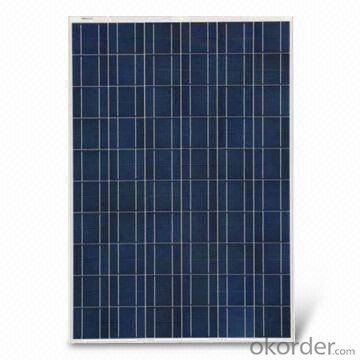
FAQ:
We have organized several common questions for our clients,may help you sincerely:
1. What’s price per watt?
A: It’s depends on the quantity, delivery date and payment terms of the order. We can talk further about the detail price issue. Our products is high quality with lower price level.
2. Can you tell me the parameter of your solar panels?
We have different series of cells with different power output, both from c-si to a-si. Please take our specification sheet for your reference.
3. How do you pack your products?
We have rich experience on how to pack the panels to make sure the safety on shipment when it arrives at the destination.
4. Can you do OEM for us?
Yes, we can.
5. How long can we receive the product after purchase?
In the purchase of product within three working days, We will arrange the factory delivery as soon as possible. The perfect time of receiving is related to the state and position of customers. Commonly 7 to 10 working days can be served.
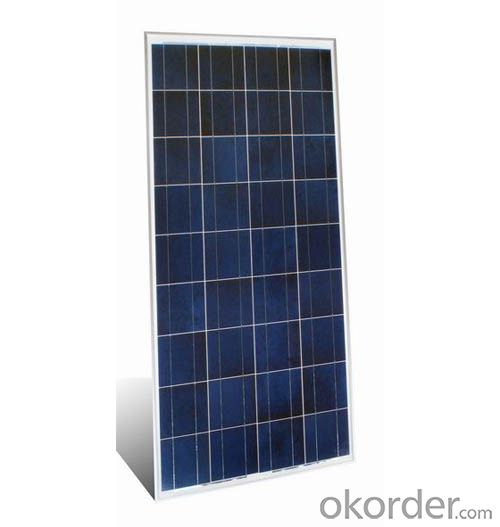
- Q: Can solar collectors be used for heating bus terminals?
- Yes, solar collectors can be used for heating bus terminals. They can absorb solar energy and convert it into heat, which can then be used for space heating in the terminal. This can help reduce energy costs and reliance on traditional heating systems, making it a sustainable and environmentally friendly option.
- Q: Can solar collectors be used in areas with limited space?
- Yes, solar collectors can be used in areas with limited space. There are various types of solar collectors available, including compact and space-efficient designs such as solar panels or solar water heaters that can be installed on rooftops or small areas. Additionally, advancements in solar technology have led to the development of innovative solutions like solar windows or solar tiles, which can further optimize the utilization of limited space for solar energy generation.
- Q: How do solar collectors affect water conservation?
- Solar collectors can have a positive impact on water conservation in several ways. Firstly, solar collectors use the sun's energy to heat water, which reduces the reliance on traditional water heating methods that require large amounts of water. This means that less water is needed to be extracted from natural sources such as rivers, lakes, or underground aquifers. Furthermore, solar collectors often employ closed-loop systems that recycle and reuse the heated water. This means that once the water is heated, it can be stored and used multiple times, reducing the overall water consumption. This is particularly beneficial in areas where water scarcity is a concern. Additionally, solar collectors can be combined with other water conservation techniques such as rainwater harvesting. By collecting rainwater and using solar collectors to heat it, the need for using potable water for various purposes such as irrigation or washing can be minimized, thus conserving water resources. Moreover, solar collectors can also be used in desalination processes to convert seawater into fresh water. This is especially valuable in coastal regions where freshwater resources are limited. By using solar energy to power the desalination process, less energy from conventional sources like fossil fuels is required, resulting in reduced water consumption and environmental impact. In summary, solar collectors contribute to water conservation by reducing the reliance on water-intensive heating methods, reusing heated water, combining with rainwater harvesting, and facilitating the desalination of seawater. These sustainable practices help to preserve water resources and promote a more efficient and environmentally friendly use of water.
- Q: Can solar collectors be used for heating zoos?
- Yes, solar collectors can be used for heating zoos. Solar collectors, such as solar thermal panels or solar water heating systems, can harness the sun's energy to generate heat. This heat can then be used to warm up areas within the zoo, including enclosures, buildings, or water bodies. By utilizing solar collectors for heating, zoos can reduce their reliance on traditional fossil fuel-based heating systems, leading to cost savings and a more sustainable approach to heating.
- Q: Is it possible to store excess energy generated by solar collectors?
- Yes, it is possible to store excess energy generated by solar collectors. This can be done using various methods such as battery storage systems, pumped hydro storage, or thermal energy storage. Storing excess energy allows for its use during periods of low or no sunlight, providing a reliable and continuous power supply.
- Q: Are solar collectors cost-effective?
- Yes, solar collectors are cost-effective in the long run. Although the initial investment may be higher compared to traditional energy sources, the long-term savings on electricity bills and the potential for government incentives make solar collectors a financially viable option. Additionally, the decreasing cost of solar technology and the ability to generate clean and renewable energy contribute to their overall cost-effectiveness.
- Q: Are solar collectors suitable for countries with limited sunlight?
- Despite the limited sunlight in certain countries, solar collectors remain a viable option. Although their efficiency may be reduced compared to countries with abundant sunlight, solar collectors are able to convert sunlight into usable energy. It is worth noting that even in countries with limited sunlight, there is still some level of solar radiation available throughout the year. In countries with limited sunlight, it is crucial to consider the type and design of solar collectors used. For example, opting for solar thermal collectors that prioritize capturing heat rather than generating electricity can be more advantageous in such regions. These collectors can be utilized for heating water or space heating, which are significant energy demands even in countries with limited sunlight. Moreover, advancements in solar technology have resulted in the creation of more efficient solar collectors that can generate energy even in low-light conditions. For instance, some solar panels are specifically designed to capture diffuse light, making them suitable for regions with limited direct sunlight. Furthermore, the integration of solar collectors with other renewable energy sources, such as wind or hydro power, can help compensate for the limited sunlight and ensure a more reliable and sustainable energy supply. Therefore, while solar collectors may not be as efficient in countries with limited sunlight, they can still serve as a viable and valuable renewable energy option, especially when combined with other renewable sources and optimized for the specific conditions of the region.
- Q: Are solar collectors scalable for large-scale use?
- Yes, solar collectors are scalable for large-scale use. They can be installed in large numbers to create solar farms or power plants, and their modular design allows for easy expansion. Additionally, advancements in technology and manufacturing processes have made solar collectors more efficient and cost-effective, making them an increasingly viable option for large-scale energy production.
- Q: Are solar collectors suitable for heating museums and art galleries?
- Yes, solar collectors are suitable for heating museums and art galleries. Solar thermal collectors can efficiently harness the sun's energy to provide heating for these spaces. They can provide a consistent and sustainable source of heat, ensuring the preservation of delicate artwork and artifacts while also reducing energy costs and carbon emissions. Additionally, solar collectors can be seamlessly integrated into the architectural design of museums and art galleries, making them a viable and aesthetically pleasing heating solution.
- Q: Can solar collectors be used in solar thermal heating and cooling?
- Solar thermal heating and cooling systems make use of solar collectors to harness the sun's energy and heat or cool buildings and spaces. These collectors, like flat plate or evacuated tube collectors, absorb solar radiation and convert it into heat. This heat can be utilized for different purposes, including heating water, space heating, or powering absorption chillers for cooling. By incorporating solar collectors, these systems offer a sustainable and renewable energy source for heating and cooling requirements, reducing dependence on fossil fuels and promoting an environmentally friendly future.
Send your message to us
Thermomax Evacuated Tube Solar Collectors Integrated with Solar Photovoltaic Polycrystalline Modules
- Loading Port:
- Tianjin
- Payment Terms:
- TT OR LC
- Min Order Qty:
- 1 pallet
- Supply Capability:
- 100000000 pallet/month
OKorder Service Pledge
OKorder Financial Service
Similar products
Hot products
Hot Searches
Related keywords







